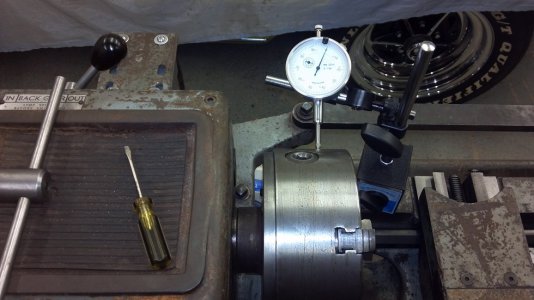You're making good progress. I wouldn't expect to see much, if any, problems with the plate only being 3/8". Unless you're cutting some really big pieces with really heavy cuts, it should do OK for most all normal purposes. I had a chuck/plate like that and it was fine. ...Only saying this to save you $$ but of course, a thicker plate is fine too!
BTW, by measuring off the side of the chuck as you're doing, you're measuring how well the chuck body is centered on the plate. Once you clean up the chuck and "de-gunk" the jaws, put a decent rod in it that sticks inside the spindle a little and indicate off the side of the rod. Do it from a set location say, 2" from the jaws. If it's out of whack, very lightly loosen the chuck/plate bolts and tap the body with a wood block and hammer. Repeat process until you indicate clean then, tighten the bolts (try to always remember that

). Next, put a larger or smaller diameter piece in there (one that still fits in the spindle) and check again. This will give you a clue if the scroll is whacky. Also, play around and see if you can re-chuck the same rod and get somewhat repeatable results. Don't lose sleep if things are off a bit here & there. Most all 3Js are. It's really a learning exercise to know what you can/can't get away with as far as re-chucking a piece goes.
While you're at it, indicate further down on the rods to see how much "wobble" you have. Of course, this somewhat depends if the shaft is straight or not but again, the purpose is to understand how things change and the types of things to consider when working on something...
Just food for thought... I'll shut up now.
Ray
I machined the back plate today and it seems to have come out ok. I didnt measure thickness of the plate, but the outer flange that is bolted to the chuck looks like its only 3/8" tops. So, I think I am going to look for a thicker back plate but this will work for now. Anyway, I machined it flat and put it back together. It was pretty easy and I checked it with an indicator afterwards and where I am measuring it in the pic below I have only about .002 of runout. I measured on the same edge of the back plate and it was 000 runout which I would have expected because I did turn it to straighten the edge out but only a small amount. I also checked the chucks on my Craftsman and Heavy 10 lathes to compare the runout. Each of them was at about .002 or .0015 respectively. SO thanks for the info. I also took the opportunity to clean the jaws of the chuck and lube it up so now it turns nice and freely. Thanks for the help!


